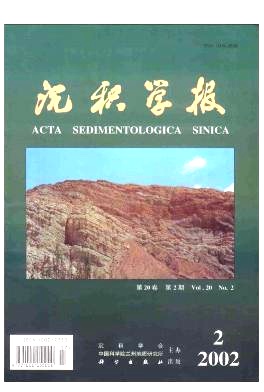HTML
| [1] | 1. Leinfelder R R,et al.The origin of Triassic reefs:current research developments and result[J].Facies,1993,31:1~56 2. Bathurst R G C.Stromatactes origin related to submarine-cemented cursts in Paleozoic mud mounds[J].Geology,1980,8: 132~134 3. Pratt B R.Stromatolitic framework of carbonate mud mounds[J].J.Sed.Geol.1982,52: 1203~1227 4. 钱宪和。微晶灰岩与微晶丘,它们的问题与成因[J].台湾中央地质调查所特刊第五号,1991.213~229 [Tsien H H.Micrites and micrite mounds,their problems and origin[J].Special issue of Center Bureau of Geological Survey,Taiwan.No.5,1991.213~229] 5. Guo L,Riding R.Microbial micritic carbonate in uppermost Permian reefs,Sichuan Basin,Southern China:some similarities with recent travertines[J].Sed.1992,39:1 067~1 069 6. Tsien H H.Contribution of reef building organisms in reef carbonate[J].Cour.Forsch-Inst.Senckenberg,1994,172: 95~102 7. Tsien H H.The role of microorganisms and the origin of micrite components in algal reefs and micrite mounds[J].Memoires Instituts Geologigue Del Univ.Catholigue de Louvain,1994b,t.xxxv: 123~135 8. De Freitas T A,et al.Silurian microbial buildups of the Canadian Arctic[J].Spec.Publs.Int.Ass.Sediments.1995,23: 151~169,393 9. Dupraz C ,Strasser A.microbialites and micro-encrusters in shallow coral bioherms (Middle to Late Oxfordian Swiss Jura Mountains)[J].Facies,1999,40: 101~130 10. Thompson J B,Ferris F G.Cyanobacteia precipitation of gypsum,calcite and magnesite from natural alkaline lake water[J].Geology,1990,18: 995~998 Neuweiler F,et al.Biosedimentology of microbial buildups.IGCP Project No.380-Proceedings of 2nd meeting,Gottingen/Germany 1996[J].Facies,1997,36:195~284 11. Chafetz H S ,Buczynski C.Bacterially induced lithification of microbial mats[J].Palaios,1992,7:277~293 12. Pedone V A,Folk R L.Formation of aragonite cement by nannobacteria in the Great Salt Lake[J].Utah.Geology,1996,24(8):743~765 13. Konhauser K O.Diversity of bacterial iron mineralization [J].Earth Science Reviews ,1998,43(1998): 91~121 14. 刘志礼。藻类及其有机质成矿作用试验[J].沉积学报,1999,17(1):9~18 [Liu Zhili,et al.Mineralization tests mode by algae and it`s organic matters[J].Acta Sedi.Sinica,1999,17(1):9~18] 16. Ehrlich H L.Geomicrobiology[M].Marcel Dekker,Inc.,NY,1981.393 17. Ehrlich H L.How microbes influence mineral growth and dissolution[J].Chem.Geo.,1996,132: 5~9 18. Ehrlich H L.Geomicrobiology:its significance for geology[J].Earth Science Reviews,1998,(45):45~60 19. Defarge C.et al.Kopara in Polynesian atolls: early stages of formation of calcareous stromatolites[J].Sed.Geo.,1994,89: 9~24 Defarge C.et al.Texture of microbial sediments revealed by cryo-scanning electron microscopy[J].J.Sed.Res.,1996,66: 935~947 20. Folk R L.SEM imaging of bacteria and nannobacteria in carbonate sediments and rocks[J].J.Sed.Petro.,1993,63: 990~999 21. 王福星。洞穴黑暗带中有无叠层石?[J].中国岩溶,1998,17(3): 278~284 [Wang Fuxing,et al.Do Stromatolites occur in the dark-zone of Karst cavers? [J].Carsologica Sinica,1998,17(3): 278~284] 22. 戎昆方。初论生物成因的洞穴叠层石的形成条件[J].中国岩溶,1998,17(3):285~290 [Rong Kunfang,et al.Developed conditions of biogenic cave stromatolite[J].Carsologica Sinica,1998,17(3): 285~290] 23. 张廷山。陕西宁强早志留世灰泥丘中微生物及其造岩意义[J].古生物学报,2000,39(2):263~266 [Zhang Tingshan,et al.Microbial fossils in Lower Silurian micritic mound,Ningqiang,Southern Shaanxi[J].Acta Palaeontologica Sinica,2000,39(2):263~266] 24. 张廷山。川西北地区早志留世陆源碎屑-碳酸盐混积缓坡[J].沉积学报,1995,13(4):27~36 [Zhang Tingshan,et al.Early Silurian siliciclastic-carbonate ramp deposites in NW Sichuan[J].Acta Sedi.Sinica,1995,13(4):27~36] 25. Richardson J B.Lower and Middle Palaeozoic records of terrestrial palynomorphs[A].In: Jansonius J & McGregor D C ed.palynology:principles and applications;American Association of Stratigraphic Palynologists Foundation[C].1996,2: 555~574 26. Peters K E,Moldowan J M 著,姜乃煌,张水昌等译。生物标记化合物指南-古代沉积物和石油中分子化石的解释[M].北京: 石油工业出版社,1995.82~149 [Peters K E,Moldowan J M.The biomarker guide: interpreting molecular fossils in petroleum and ancient sediments.Prentice Hall,Inc.,1993 (Translated by Jiang Daihuang and Zhang Shuichang,et al)。Beijing:Petroleum Industry Publishing House,1995.82~149] |






 DownLoad:
DownLoad: